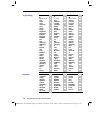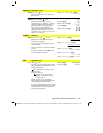
414 Appendix A: Functions and Instructions
8992APPA.DOC TI-89 / TI-92 Plus: Appendix A (US English) Susan Gullord Revised: 02/23/01 1:48 PM Printed: 02/23/01 2:21 PM Page 414 of 132
abs()
MATH/Number menu
abs(
expression1
)
⇒
expression
abs(
list1
)
⇒
list
abs(
matrix1
)
⇒
matrix
Returns the absolute value of the argument.
If the argument is a complex number, returns
the number’s modulus.
Note: All undefined variables are treated as
real variables.
abs({p/2,
ë
p/3})
¸
{
p
2
p
3
}
abs(2
ì
3
i
)
¸
13
abs(z)
¸
|z|
abs(x+y
i
)
¸
x
2
+
y
2
and
MATH/Test and MATH/Base menus
B
oolean expression1
and
expression2
⇒
Boolean expression
B
oolean list1
and
list2
⇒
Boolean list
B
oolean matrix1
and
matrix2
⇒
Boolean
matrix
Returns true or false or a simplified form of
the original entry.
x‚3 and x‚4
¸
x‚4
{x‚3,x0} and {x‚4,x
ë
2}
¸
{x
‚
4 x
ë
2}
integer1
and
integer2
⇒
integer
Compares two real integers bit-by-bit using
an
and
operation. Internally, both integers are
converted to signed, 32-bit binary numbers.
When corresponding bits are compared, the
result is 1 if both bits are 1; otherwise, the
result is 0. The returned value represents the
bit results, and is displayed according to the
Base
mode.
You can enter the integers in any number
base. For a binary or hexadecimal entry, you
must use the 0b or 0h prefix, respectively.
Without a prefix, integers are treated as
decimal (base 10).
If you enter a decimal integer that is too large
for a signed, 32-bit binary form, a symmetric
modulo operation is used to bring the value
into the appropriate range.
In Hex base mode:
0h7AC36 and 0h3D5F
¸
0h2C16
In Bin base mode:
0b100101 and 0b100
¸
0b100
In Dec base mode:
37 and 0b100
¸
4
Note: A binary entry can have up to 32
digits (not counting the 0b prefix). A
hexadecimal entry can have up to 8 digits.
Alphabetical Listing of Operations
Operations whose names are not alphabetic (such as +, !, and >) are listed at the end of
this appendix, starting on page 526. Unless otherwise specified, all examples in this
section were performed in the default reset mode, and all variables are assumed to be
undefined. Additionally, due to formatting restraints, approximate results are truncated at
three decimal places (3.14159265359 is shown as 3.141...).
Important:
Zero, not the letter O.


















